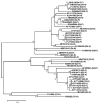Genotype-4 hepatitis E in a human after ingesting roe deer meat in South Korea
- PMID: 24133670
- PMCID: PMC3796682
- DOI: 10.3350/cmh.2013.19.3.309
Genotype-4 hepatitis E in a human after ingesting roe deer meat in South Korea
Abstract
The recent increase in the number of cases of indigenous hepatitis E virus (HEV) infection highlights the importance of identifying the transmission routes for the prevention of such infections. Presented herein is the first case of acute HEV infection after ingesting wild roe deer meat in South Korea. A 43-year-old male presented with abdominal discomfort and jaundice. He had not recently traveled abroad, but had eaten raw roe-deer meat 6-8 weeks before the presentation. On the 7th day of hospitalization the patient was diagnosed with acute viral hepatitis E. Phylogenetic analysis of his serum revealed genotype-4 HEV. This case supports the possibility of zoonotic transmission of HEV because the patient appears to have been infected with genotype-4 HEV after ingesting raw deer meat.
Keywords: Genotype 4 hepatitis E; Roe deer; South Korea.
Conflict of interest statement
The authors have no conflicts to disclose.
Figures


Similar articles
-
Prevalence and phylogenetic analysis of hepatitis E virus in pigs, wild boars, roe deer, red deer and moose in Lithuania.Acta Vet Scand. 2018 Feb 23;60(1):13. doi: 10.1186/s13028-018-0367-7. Acta Vet Scand. 2018. PMID: 29471843 Free PMC article.
-
Characterization and zoonotic potential of endemic hepatitis E virus (HEV) strains in humans and animals in Hungary.J Clin Virol. 2009 Apr;44(4):277-81. doi: 10.1016/j.jcv.2009.01.008. Epub 2009 Feb 12. J Clin Virol. 2009. PMID: 19217346
-
The first case of genotype 4 hepatitis E related to wild boar in South Korea.J Clin Virol. 2011 Mar;50(3):253-6. doi: 10.1016/j.jcv.2010.11.005. Epub 2010 Dec 3. J Clin Virol. 2011. PMID: 21130029
-
Laboratory challenges in the diagnosis of hepatitis E virus.J Med Microbiol. 2018 Apr;67(4):466-480. doi: 10.1099/jmm.0.000706. Epub 2018 Feb 27. J Med Microbiol. 2018. PMID: 29485390 Review.
-
Zoonotic origin of hepatitis E.Curr Opin Virol. 2015 Feb;10:34-41. doi: 10.1016/j.coviro.2014.12.006. Epub 2015 Jan 9. Curr Opin Virol. 2015. PMID: 25588602 Review.
Cited by
-
Recent Hepatitis E Virus Infection in Wild Boars and Other Ungulates in Japan.Viruses. 2025 Apr 4;17(4):524. doi: 10.3390/v17040524. Viruses. 2025. PMID: 40284967 Free PMC article.
-
A Korean patient with Guillain-Barré syndrome following acute hepatitis E whose cholestasis resolved with steroid therapy.Clin Mol Hepatol. 2016 Sep;22(3):396-399. doi: 10.3350/cmh.2015.0039. Epub 2016 Aug 30. Clin Mol Hepatol. 2016. PMID: 27572076 Free PMC article.
-
Current Knowledge of Hepatitis E Virus (HEV) Epidemiology in Ruminants.Pathogens. 2022 Sep 29;11(10):1124. doi: 10.3390/pathogens11101124. Pathogens. 2022. PMID: 36297181 Free PMC article. Review.
-
First Report of the Presence of Hepatitis E Virus in Scottish-Harvested Shellfish Purchased at Retail Level.Food Environ Virol. 2018 Jun;10(2):217-221. doi: 10.1007/s12560-018-9337-5. Epub 2018 Feb 13. Food Environ Virol. 2018. PMID: 29442296 Free PMC article.
-
No Evidence of Hepatitis E Virus Infection in Farmed Deer in Germany.Food Environ Virol. 2020 Mar;12(1):81-83. doi: 10.1007/s12560-019-09407-y. Epub 2019 Oct 17. Food Environ Virol. 2020. PMID: 31625032
References
-
- van Cuyck-Gandré H, Zhang HY, Tsarev SA, Clements NJ, Cohen SJ, Caudill JD, et al. Characterization of hepatitis E virus (HEV) from algeria and chad by partial genome sequence. J Med Virol. 1997;53:340–347. - PubMed
-
- Arankalle VA, Chobe LP, Joshi MV, Chadha MS, Kundu B, Walimbe AM. Human and swine hepatitis E viruses from western india belong to different genotypes. J Hepatol. 2002;36:417–425. - PubMed
-
- Shukla P, Chauhan UK, Naik S, Anderson D, Aggarwal R. Hepatitis E virus infection among animals in northern india: An unlikely source of human disease. J Viral Hepat. 2007;14:310–317. - PubMed
-
- Kwo PY, Schlauder GG, Carpenter HA, Murphy PJ, Rosenblatt JE, Dawson GJ, et al. Acute hepatitis E by a new isolate acquired in the united states. Mayo Clin Proc. 1997;72:1133–1136. - PubMed
-
- Kabrane-Lazizi Y, Zhang M, Purcell RH, Miller KD, Davey RT, Emerson SU. Acute hepatitis caused by a novel strain of hepatitis E virus most closely related to united states strains. J Gen Virol. 2001;82:1687–1693. - PubMed
Publication types
MeSH terms
Substances
LinkOut - more resources
Full Text Sources
Other Literature Sources

